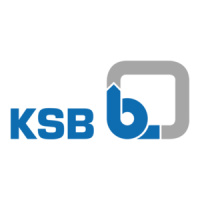
Do you have a question about the KSB MEGAFLOW 150-400 and is the answer not in the manual?
| Type | Centrifugal Pump |
|---|---|
| Flow Rate | Up to 2000 m³/h |
| Operating Pressure | Up to 16 bar |
| Seal Type | Mechanical seal |
| Connection Type | Flanged |
| Casing Material | Cast iron, Stainless steel |
| Speed | Up to 2900 rpm |
| Material | Cast Iron, Stainless Steel |
| Application | Water Supply, Irrigation |
| Impeller Type | Closed |
Lists bearing types, sizes, and maximum allowable pressures for various pump sizes and impellers.
Details maximum impeller diameters based on pump size, impeller type, and liquid density.
Explains the process of base grouting, ensuring a secure and stable foundation for the pump.
Describes how to check and achieve proper leveling of the pump base plate using shims.
Details the requirements for grout composition and application for vibration-free mounting.
Explains the importance and procedure for aligning the pump and motor shafts using dial indicators.
Provides guidelines for installing the suction piping to ensure optimal performance and prevent issues.
Offers recommendations for installing the discharge pipeline to manage overpressures and flow.
Lists essential checks and preparations required before the initial startup of the pump.
Outlines critical monitoring and adjustments to be made immediately after the pump starts running.
Recommends routine checks for monitoring pump performance and identifying potential issues.
Details the correct sequence of steps for safely shutting down the pump.
Explains how to perform maintenance on the pump's bearings, including oil filling.
